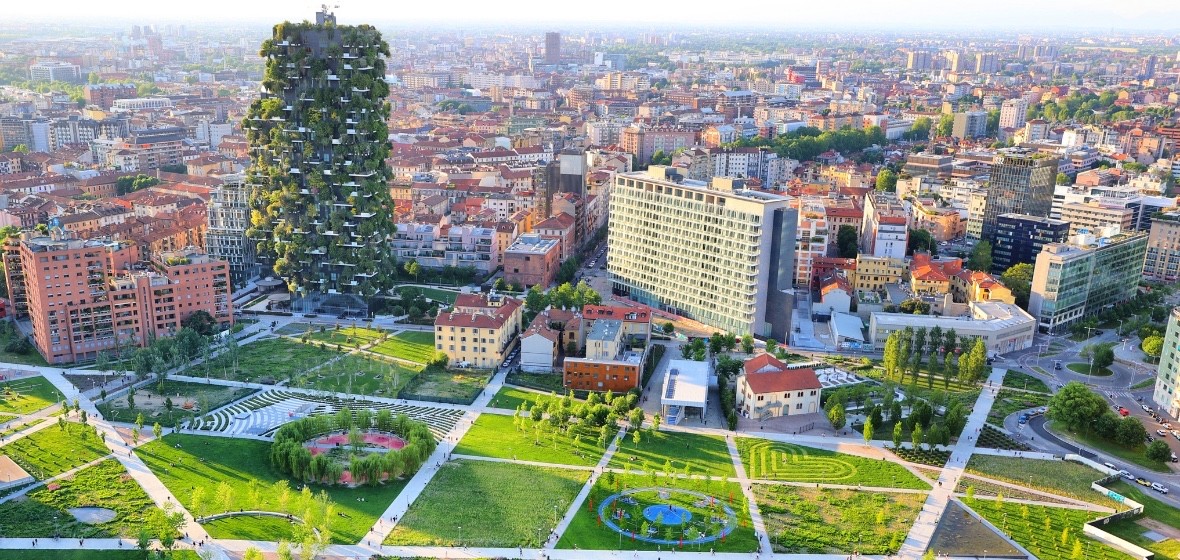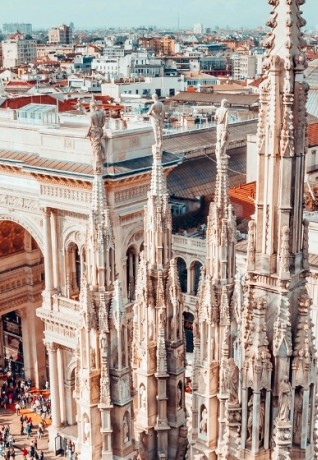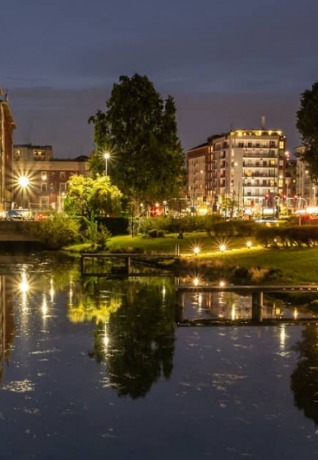Northern Milano was formerly industrial and is still more densely inhabited than South Milano.
Although very urban and mostly redeveloped, it is much greener than Central Milano thanks to its old trees, giant parks and cascinas.
North Milano is global wealth and young bohemia, and especially working-class and multiethnic, Arab-Milanese and Chinese-Milanese.
The new skyline of Milano is here, with the Porta Nuova and City Life skyscrapers.
Chinatown and Isola, some of the best parts of the city to spend an evening are in the North, too.
And so is the Farini railway yards where a major urban transformation project is transforming the area with a new urban forest.
HOW TO GET THERE
Metro M3 Yellow: Zara, Maciachini – Metro M2 Green: Garibaldi FS – Metro M5 Lilac: Marche, Istria, Isola, Garibaldi FS, Tre Torri, Portello
The neighborhood in front of the Garibaldi FS Station recently underwent deep transformation and urban redevelopment, which culminated in the early 2010s with the construction of the skyscrapers of the Milano Porta Nuova project that changed the skyline of the city forever.
Piazza Gae Aulenti, inaugurated in 2012, is the heart of the Milan business center and is at the foot of the Unicredit Tower, the tallest skyscraper in Italy. In Piazza Gae Aulenti it is nice to stroll to observe the display spaces of the stores of global brands, but also to admire the water features of the fountain, which gushes directly from the ground.
From Piazza Gae Aulenti a maze of walkways and cycle paths leads to Isola through BAM, the open-air botanical library, one of the newest and most innovative public parks in Milan - as well as one of the most instagrammed. With a fascinating collection of tree and flower species, it is perfect for a moment of relaxation.
Garibaldi FS is one of the main access points to the city thanks to the surface railway station and the underground station of the Passante, with trains serving both regional and national and international routes (such as the TGV to Paris).
Piazza XXV Aprile around the Garibaldi Gate is one of the most inviting new spaces in Milan. It houses one of the best cinemas in Milan and is dotted with cafes and delis from global brands. Coming from Corso Garibaldi, lively and interesting, with shops and theaters, clubs and restaurants, you will see the silhouettes of Gae Aulenti's skyscrapers. A few steps from 25th April stands the future Pyramid of the Feltrinelli and Microsoft Foundation, with the space between via Crispi and piazza Baiamonti entirely renovated and used for pedestrian use, with the exquisite Lea Garofalo community garden.
Isola, the Island, so called because it is isolated by the railway tracks from the rest of the city, acts as an urban bridge between old and new. Until the 1970s it was the reign of the burglars of the Ligera, the Milanese underworld. Then, starting in the 1990s, young artists and activists moved to the neighborhood. Isola soon became one of the hippest neighborhoods in the city. Then the impressive urban transformation and gentrification taking place in the 2000s and 2010s, which opened the neighborhood to the rising Milan of the future, symbolized by the Vertical Forest, one of the architectural masterpieces of the century. A skyscraper that is also a wood of trees. Not just a building, but also the concrete symbol that another idea of a city, more sustainable, greener, more innovative, is possible.
In a few hundred meters coexist the futuristic towers that have changed the skyline and the shops and squares where subcultural Milano is constantly reproduced according to ever new codes and environments. A neighborhood of young creatives and alternative families where you can embrace new trends, spend your free time and be a protagonist of change in the city.
WHY GO THERE
To go and have an aperitif in atmospheric bars, listen to a jazz concert or go out for dinner in the evening district most loved by and by the Milanese along with the Navigli.
Piazzale Archinto, recently entirely pedestrianized and green with children's play areas with characteristic and noisy bars, and Piazza Minniti, the market square barely colored by tactical urbanism, which is the heart of Isola. From there, streets branch off such as via Borsieri filled with clubs, pizzerias, kebabs, trattorias, restaurants and various humanity at all times of the day.
Many cultural and environmental associations are active between via Confalonieri and via de Castillia, a space which now includes new well-equipped parks for children, where adults can sip espresso or eat poké.
Noteworthy is the Ciclofficina, run by veterans of Critical Mass. A workshop where anyone can learn to repair their bicycles, because this is a neighborhood with an ecological conscience, where people love to bike.
Together with the skyscrapers of Porta Nuova, the new Tre Torri district has helped transform the aesthetics of the city, which can now boast one of the most elegant skylines in Europe.
The three skyscrapers of Zara Hadid (the Twisted), Arata Isozaki (the Straight) and Daniel Libeskind (the Curved, designed by the architect of the Liberty Tower in New York) stand out imperiously, clearly visible from Corso Sempione and other areas of the city.
This os the CityLife luxury district, with a ritzy shopping mall and well-kept vast park, one of the most prestigious and futuristic projects born in Milan on the occasion of EXPO 2015.
Tre Torri extends from piazza Giulio Cesare to piazza Carlo Magno and is a wonderful place to visit, especially at sunset on a beautiful day.
WHY GO THERE
City Life consists of a large park with kiosks, playground equipment and green spaces open to the public, white residential buildings with wood and metal finishes in the French Riviera style, and of course the Three Towers which are the headquarters of banks and multinationals, and for the joy of all the teenagers of the city, the newest and coolest shopping center in Milan aka CityLife Shopping District, which looks like it came out of California for glitz and design, but is directly accessible from the subway.
Once upon a time, the Milan Trade Fair stood here, demolished between 2007 and 2008 to make way for this ambitious urban redevelopment plan, the largest in Europe. The FieraMilanoCity building, which hosts smaller events (toy fairs, philatelic exhibitions, electronic gadgets, etc.) since the Fiera moved to Rho-Milano, has been covered with a metal structure from a sci-fi movie that surrounds it as in a cloud.
Here is the headquarters of the MiCo, the Milan Convention Center, the largest congress center in Europe.
Equally affected by a very recent urban transformation is the neighboring area of the Portello, which during the economic miracle designated the site of the factory where Alfa Romeos were produced. A new pedestrian bridge over the elevated ring road (viale Serra) connects the neighborhood through the new and popular park with the characteristic spiral hill, which is somewhat reminiscent of the mountain of Purgatory, to the very large square with an almost metaphysical panorama, where the triangular construction of Casa Milan and the headquarters of various technological and financial companies stand up in silence. A short distance away, towards Piazzale Accursio, is the Portello shopping center, which serves the residential area around piazzale Damiano Chiesa.
Between the Monumental Cemetery and Corso Sempione lies Milano’s Chinatown, the largest in Europe after Paris.
Its history begins a century ago when the first Chinese families migrated to the area around via Paolo Sarpi.
In the 1980s and 1990s, Chinatown grows dramatically, expanding to via Bramante and via Rosmini.
In the 2000s, via Sarpi is finally pedestrianized and Chinese gastronomy starts differentiating, with specialized supermarkets and gourmet proposals, as well as the very popular Shanghai-style dumpling shop working in tandem with a 100% Milanese butcher's shop.
With Inter Milano (and also AC Milan for a period) being the property of Chinese entrepreneurs, Chinatown is increasingly the place to be for the smart Milanese, who choose it for a walk, a different kind of shopping and to always look for new places to go to dinner, have a cocktail and sing in a karaoke party.
WHY GO THERE
Paolo Sarpi is the main artery of Chinatown, pedestrianized and one of the most pleasant walks in Milan, day and night: Asian street food, Chinese restaurants (Cantonese, Sichuan, Shanghai or Hong Kong) and the Chines import shops for food and clothing meet typical Italian patisseries, pizzerias and shops, in a surprising succession of tastes and trends. If before it was above all cheap, now Sarpi is also chic!
For the Cimitero Monumentale: one of the most surprising places in Milan, easily reachable now with the lilac metro, which offers eternal peace to the richest or most famous Milanese and offers a place of aesthetic tranquility even to the living. The imposing neoclassical building at the entrance conceals wide paths of white gravel where sumptuous tombs and funeral temples stand: the Milanese bourgeoisie of the late 1800s indulged in creating eclectic and even bizarre mausoleums to celebrate their greatness. An open-air museum where you can get lost on a sunny morning when the Monumental Cemetery is nearly empty.
For the new ADI Museum. The Compasso d'Oro, established in 1954 by architect Gio Ponti, is the international award that goes to the most iconic and innovative industrial design projects, honoring the designers who created them. The museum collects all 350 award-winning products and creations that have revolutionized everyday life over the decades.
For the Fabbrica del Vapore, an exhibition venue with a rich program of art shows, the perfect bistro for a break and many events and for social gatherings and debates even outdoor.
Dergano is the northern frontier of the Milanese creative class.
A quintessentially Milanese village that stood out during the Resistance, it was transformed by the arrival of the subway 10 years ago.
Its railing houses and lofts have begun to be populated by people under 40s with or without children and the neighborhood has become an epicenter of Milanese social life both day and night.
To the north, Dergano is separated from Affori by the railway bridge, while to the east it is bordered by via Imbonati: one side of the road is proudly Arabic, the other is advanced tertiary sectort with hypermodernist buildings and a mega-sized gym for office workers. To the west there the Bovisa Polytechnic and to the south piazzale Maciachini and the Farini area.
Piazzale Maciachini is a large square where the trams for Niguarda depart and via Imbonati starts. It is a lively area, with different ethnic groups and social classes and traffic of people at every hour.
The disused railway yard behind the Monumental Cemetery is the subject of a massive urban redevelopment: Scalo Farini and Scalo Romana are the frontiers of city development in the years to come. It is a neighborhood with a popular and commercial soul, located between alternative Isola and multiethnic Imbonati.
After the great urban transformation that has just begun, the Scalo Farini will contain a large urban forest and will host the new Campus for the Arts, the new headquarters of the Brera Academy of Fine Arts. A new bridge will connect the district directly to Dergano.
WHY GO THERE
For Dergano’s boho atmosphere between sophisticate and personable - you always feel at home, but it’s like the East Village of NYC: people are not in a hurry and cyclists and vegans abound. Visit piazza Dergano, formerly jammed by the flow of cars, now a 30 km/h slow driving area, made possible by the repainted and pedestrianized tactical square, with ping pong tables and a bike sharing station. All around there are popular coffee shops, quality bakeries, Filipino restaurants and cafés-bookstores where the whole neighborhood gathers.
To stroll and shop in via Farini, a very long artery developed on the trail of the ancient northern road that led from the center to the historic Porta Comasina district.
It begins in Piazza Baiamonti, runs alongside the Monumental Cemetery and after having passed the railway it ends in Piazzale Maciachini. Beyond the bridge with a view of the skyscrapers around the Garibaldi station, the street explodes in a termite mound of commercial activities: bakeries, haberdashery, the headquarters of Danone, pizzerias, delicatessens, Asian and Latin groceries, kebabs and fried chicken. The tram rattles by and people swarm in this street which well represents the new popular Milan, with contributions from all regions of Italy and the world.
There are many nightclubs and trendy food joints in this formerly industrial area of Milan that has undergone a lot of transformation since the 2000s, thanks to the opening of the yellow and lilac subway lines and the Lancetti station of the Passante underground railway.
It is a very lively district both day and night, with many restaurants for those who love Italian, Chinese, Indian, Pakistani, Arab, Mexican cuisine, which go to constitute a citadel of taste that extends from Via Valtellina to Piazza Pasolini.
To the west of Viale Zara, there is the Villaggio dei Giornalisti, so called due to the concentration of publishing professionals who have concentrated there since the 1930s, around Villa Mirabello. It is a neighborhood made up of houses and villas from the early and mid twentieth century surrounded by trees and greenery, some designed by famous architects, making it one of the most beautiful and underexplored neighborhoods in Milan. Between via Melchiorre Gioia and Piazza Carbonari, there is the Maggiolina, an Arcadian village made up of nineteenth-century houses with a garden among a maze of flower-filled streets, sheltered from the hustle and bustle of the surrounding busy streets.

 Log in
Log in


